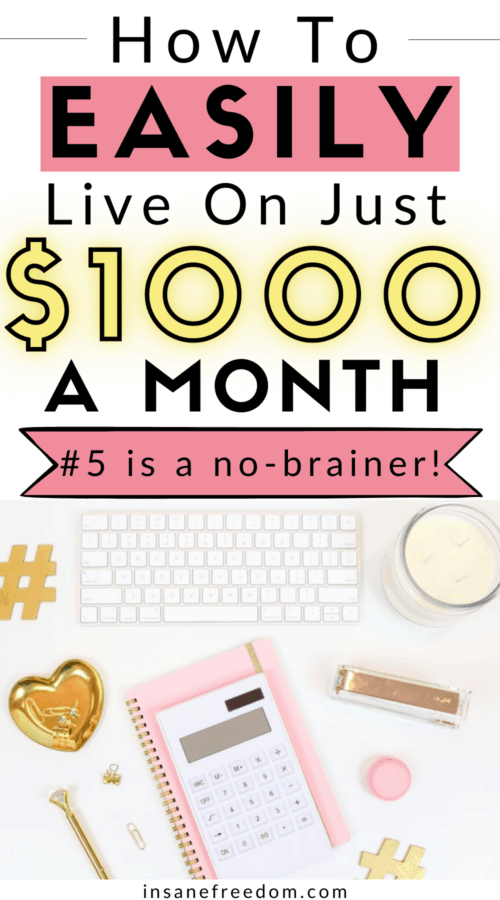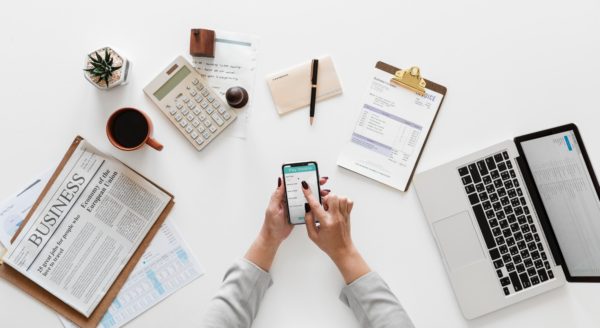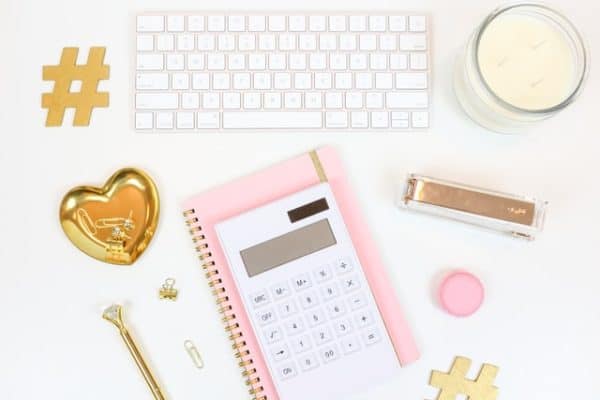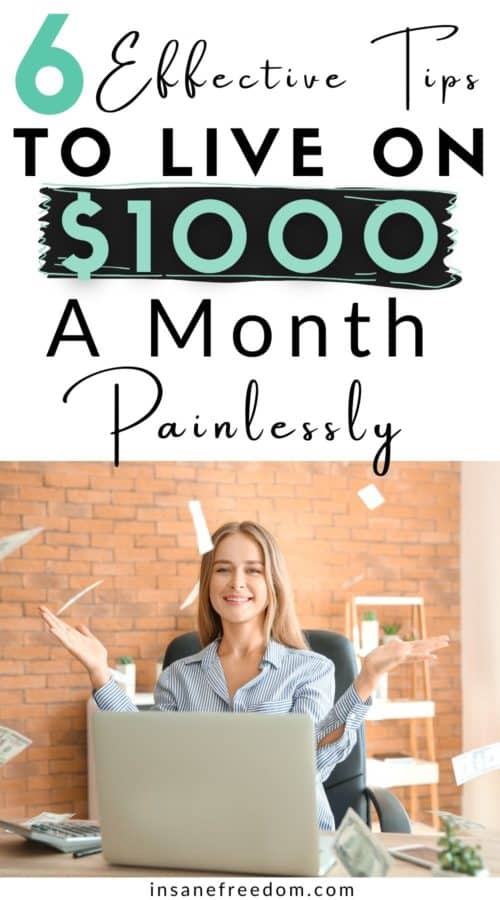For one thing, keeping your costs to under a thousand per month can prove to be a valuable lifeline if your time and resources are already stretched to the limits, and yet you’re still no closer to where you want to be financially.
And if that side hustle you’re so passionate about is producing results? Well, lowering your outgoings while increasing your income is only going to amplify your results.
Learning to live on $1,000 a month can also be very useful if what matters most to you isn’t having more money, but more time. With your finances well managed, you can spend less time working and more time doing the things you really love.
Still, living on so little is easier said than done, right? Not necessarily.
Here are 6 top tips to help you keep your costs under control and survive on $1,000 or less each and every month.
How to Live on 1,000 A Month: 6 Top Tips
Contents

1. Take Stock Of Your Spending
OK, so it’s hardly the most exciting tip in the world, but you’ll find it much harder to manage your money properly if you don’t know where it’s all going.
First things first then, you’re going to need to take an inventory of everything that you spend money on.
This will help you not only to identify any unnecessary spending but also to come up with ideas about how you can minimize your spending. Once you are aware of your spending habits, it also pays to stick to a monthly budget each month.
Doing so will help you survive on $1000 a month and build the financial foundations you need to achieve financial freedom!
Grab these free budget tracker printables to get started:
35+ Free Printable Budget Trackers To Manage Your Money Better
How to Do it:
The easy way to do this is to take a good look at all of your bank and credit statements from the last 2-3 months. Don’t forget to look at your digital accounts like PayPal and Stripe too.
Open up a blank spreadsheet (you can do this for free using Google Docs) and create two columns, one will be for the name of the thing you spent money on (rent, coffee, etc.) and another for the cost.
If you do not want to use a spreadsheet, budgeting apps like Goodbudget and EveryDollar will work just as well. This may reveal some surprising spending habits.
For example, spending a few dollars on that morning coffee may not seem like much at a time, but it all adds up over the course of a month.
It may even bring up some things you didn’t even realize you were still paying for, like that streaming service you haven’t watched in months or a membership to the gym you haven’t visited since the New Year.
2. Cancel Your Subscriptions and Memberships

This is usually the point in these types of articles where you’re told to look at those subscriptions and memberships that you don’t need or don’t use and cancel them.
It’s fair advice, but the problem with it is that we can easily kid ourselves that we really will go back to the gym soo or that even though we haven’t watched Netflix in ages, we’re absolutely going to get round to that third series of Cobra Kai any day now.
When we do this, we become reluctant to cancel anything at all and end up making no progress on reducing our expenses.
That’s why, rather than unsubscribing on a service-by-service basis, it’s better to simply cancel everything all at once and then re-subscribe only to those services that you’re genuinely going to use, when you’re going to use them.
This way, you’re not missing out on anything. If something genuinely brings value into your life then you can pay for it, but it could well save you money if you spend months paying for a service that you’re not using just so that you could potentially use it at some point in the future.
You can easily do a monthly subscription audit using this Subscription Tracker. With so many subscriptions that are in auto-renewal these days, it pays to keep track of how much you spend on monthly subscriptions! With this fillable Subscription Tracker, you can download it and instantly use it on your phone without even printing it out.
Here are some things you can do to further reduce your monthly bills:
- You can easily cancel and manage your subscriptions with the RocketMoney app. Basically, the app helps you find and cancel any unwanted subscriptions, track your spending and lower your bills! Sign up for the free RocketMoney account to get started.
- Wish you can reduce your monthly bills with just the click of a button? Trim helps you literally save money automagically by negotiating your cable, internet and phone bills. That’s not all – this clever app also helps you find subscriptions you no longer use and cancel them. Grab the free Trim app here to easily help you manage your finances in seconds.
Bonus Tips:
- On a related note, just because you do sign back up to a service after you’ve previously unsubscribed, there’s no reason why you can’t unsubscribe once you’re done with it. For example, if you’re signing up to Amazon Prime to watch a specific series, you can always cancel again once you’ve watched that series.
3. Check You’re Getting the Best Deal

Obviously, there are some things you won’t want to cancel, like your home energy supply, your Internet and phone plans for example, but that doesn’t mean that you have to pay over the odds for them.
One of the best ways to live on only $1,000 is to check that you’re getting a better deal on your bills and switch to lower-priced plans wherever possible.
Tools like BillTrim can help you to negotiate your cable, Internet, phone, and even medical bills to ensure you’re getting the best possible deals for your budget. Similar services exist for your utility bills and even your home and car insurance.
You might also like:
ShopBack 2022 Review: Your Complete Guide to the Popular Cashback App
4. Cut Your Travel Costs Where Realistic
If you live out in the sticks with a 50-mile commute to your nearest grocery store and limited public transport options then, sure, your car is a worthwhile investment that you’ll no doubt rely on.
However, if you live in or near a city with stores, schools, and your place of work all within a reasonably manageable distance, then you may have other options that can help you save a lot of money.
Taking the bus or train everywhere is certainly going to save you money, especially when you factor in things like vehicle tax, insurance, maintenance, and fuel.
You could even work on your financial and health goals at the same time by investing in a good quality bicycle and using that to get around instead of your car.
Try this out for a while and you may find that you can do everything from grocery shopping to commuting to work without the need for a car. In that case, you could even sell your car to make a little extra cash which could make it much easier to achieve your financial goals even on a lower income.
5. Stay Home And Cook
According to the U.S. Bureau of Labor Statistics (BLS) Consumer Expenditure Survey, Americans spend an average of $660 per consumer per month on food, with $228 of that being spent on eating out, deliveries, and snacks from vending machines.
Obviously, if you’re going to live well on $1,000 per month that figure is going to have to drop. The simple way to do this is to eliminate eating out altogether and cook all of your meals yourself.
You could cook a batch of healthy nutritious meals at once and freeze them so that you don’t have to spend so much time preparing food every time that you come home from work ready for a quick dinner. What’s more, cooking your own meals with fresh vegetables and other healthy ingredients is only going to improve your long-term health, especially if you pair it with the last suggestion to swap your car for a bike.
Not only is this good for your body, it could also be good for your wallet.
Think about it: The healthier you are, the less money you will have to spend on medical bills. You may even find that your health insurance is lower, too.
Here are some things you might want to check out to help you cook more often at home:
- If you struggle with eating at home, $5 Meal Plan is a great way to get meals sent straight to your email. It’s a subscription that I use and it has been amazing! As a busy entrepreneur, I sometimes neglect meal planning but these meal plans are an amazing time and sanity saver.
- Eating more vegetables or adopting a vegan diet will significantly reduce your weekly grocery bill. Check out these budget-friendly vegan recipes and start cooking them at home.
6. Make Paying Off Debt a Priority

Even if you follow all of the above five tips to the letter, you’ll find it much harder to live on a thousand dollars if you’re paying off credit cards, loans, and other debts each and every month.
So, while it might mean harder work at first, paying off those debts should absolutely be your top priority. When every penny you earn belongs to you rather than your credit card company, you can make better decisions about where that money goes and can make your $1,000 go a lot further.
This means that you’ll not only find it much easier to live on that amount but that you’ll be able to do so much more comfortably and still enjoy a good standard of living. Who knows, being debt-free may even mean you don’t have to cancel that Netflix account after all.
More ideas on how to pay off debt:
- Paying off debt starts with learning how to control your spending impulses. Check out these quick tips on how to stop overspending money.
- Try the 30 Day Savings Challenge to make saving money into a game, rather than a painful exercise.
- A no spend challenge helps you boost your savings, while also helping you unlearn money habits that keep you stuck in a pay check to pay check loop. Try the no spend challenge for a week, month, or any length of day you want.
The Real Benefit of Living on $1,000 A Month

At first glance, living on $1,000 a month may seem like an unattainable goal, one that’s bound to be all about sacrifice, scarcity, and living without.
Look a little closer, however, and you’ll soon see that not only is it possible, but it could also lead to big improvements in other areas of your life that make day-to-day living much more comfortable and enjoyable.
Spend more time cycling to work and eating home cooked meals than taking the car to Arby’s every day, for example, and you’ll not only save money but actually improve your quality of living in the process, ultimately making the process of achieving your financial goals all the more worthwhile.
Related articles:
15 Great Depression Frugal Living Tips Still Relevant In 2022

